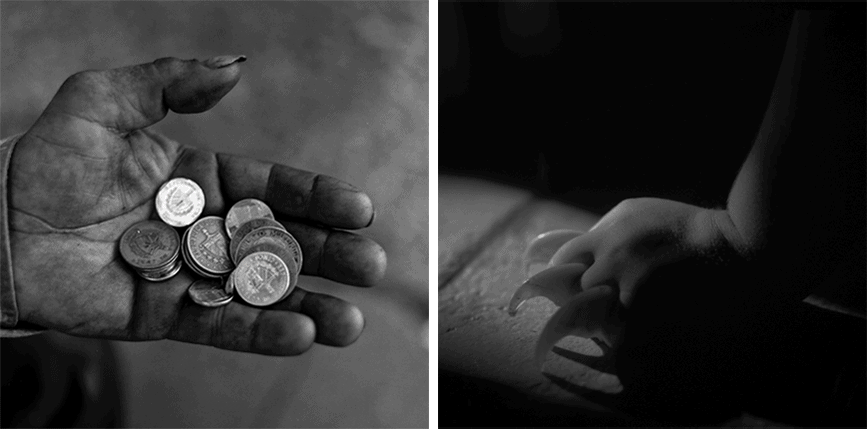From the Negative: Juan Carlo Alom
 Left: República de Cuba, 2012
Left: República de Cuba, 2012
Right: Puño de tigre, 2010
Juan Carlos Alom was born in Cuba in 1964, studying photography at the Semiotica del Entorno Cubano at the Institute of International Journalism, in Havana. Alom started his career working as a photojournalist for the Cuban Press in 1985, which led him to experiment with the photographic medium while studying photo restoration and conservation with the photographer, Gerardo Suter at the Fototeca de Cuba in 1989. This experimentation led Alom to create a body of work that marks his personal style. Alom’s photographs have been visibly manipulated by his hand and are recognizable for its dark backgrounds which act as metaphors for the mythical themes of his images. He actively works in experimental photography as well as film and video, and is also responsible for founding a studio in Cuba where artists can work and screen their videos.
His work participates in the generational impulse of the 1990s, committed to oxygenate the old discourses and aesthetic presuppositions of the genre. 1989 is a year that marked the end and the beginning of a period in the life of all Cubans. The economic crisis tested the values of a utopian society that was entering the last decade of the twentieth century in a new period that came to be known as the Special Period.[1] This sheds light into the interpretation of the Alom’s work in República de Cuba (2012) and Puño de tigre (2010), esteemed pieces within the Adrastus Collection, both demonstrating the brutal and almost cruel reality of the utopian society of Cuba. Alom describes his body of work, as:
“I had hardly begun working as a photojournalist when the scarcity brought about by the Soviet Union’s collapse obliged me to experiment, shaping my artistic vision into one that is driven by precariousness, spontaneity and the necessity to focus on distinct themes such as Afro-Cuban religion, youth, longitude. Even more than those isolated themes, my idiosyncrasy, as both a filmmaker and photographer, entails the quest to document the impossible.”[2]
Both República de Cuba (2012) and Puño de tigre (2010) are photographs in black and white of hands, one old with a cluster of coins in its palm and the other with a less rough hand, clenched with claws jutting out from the sockets as if a make-shift animal paw. The difference in the backdrop is also prominent as República de Cuba (2012) has a brighter setting, one of the cobbled streets, which are out of focus but can be assumed to be set in Havana, Cuba, while Puño de tigre (2010) has a jet-black framework with only a peephole of light shining on the hand. His work often incorporates elements of ritual, magical realism, and his incorporation of the hands suggests this ritualistic and almost magical transformation of the body part. His elements of Afro-Cuban religion set into tableaux that he then photographs, communicating a personal imagery while also reflecting upon universal themes of his culture.
Juan Carlos Alom’s recent solo exhibitions include 2015: Island’s Creatures, El Apartamento Gallery, Vedado, Havana.2012 : Juan Carlos Alom, Photographs (1989 – 2012), Buzz Art Gallery, Wynwood Arts District, Miami, Florida, USA. 2009: Esperamos en el Monte Claro, Galería Villa Manuela, Havana, Cuba; Monte Soy, Galería El Torco, Santander, Spain ; Culto a la Vida, Habana Cultura, Madrid, Spain; Evidencia, Iturralde Gallery, Los Angeles (2001); and Secret Shadows, Throckmorton Fine Art, New York (2000). Recent group exhibitions include Shifting Tides: 2014: Algo que punza. Punctum Espacio. Mexico City, Mexico; Without Masks: Contemporary Afro-Cuban Art, Audain Gallery, Museum of Anthropology, Vancouver, Canada. 2012: La Virgen de La Caridad del Cobre. Centro Nacional para las Artes, Mexico City, Mexico; La Virgen de La Caridad del Cobre. Catedral de México, Mexico City, Mexico. 2011:Tabakalera, Fábrica de Cultura Visual, Daros Latinamerica, San Sebastian, Spain; Últimas Escenas (posters for scripts by Tomás Gutiérrez Alea that were never made), Centro de Arte 23 y 12, Havana, Cuba. 2010: Polaridad Contemporánea: Recent Works from Cuba. New Orleans Museum of Art, New Orleans, USA; Serendipity. Bienal Portugal Arte 10 EDP, Lisbon, Portugal; Contemporary Afro- Cuban Art. Without masks. The Johannesburg Art Gallery, South Africa; Océano Digital, Tecnología en el Arte, Centro Provincial de Artes Plásticas Fundación Rafael Botí. Córdoba, Spain; Cuban Photography After the Revolution, Los Angeles County Museum of Art (2001) and From the Negative, Conceptual Photography from Cuba, Photographic Arts, Minneapolis (2000). Alom lives and works in Havana.
[1] Alom, Juan Carlos. “Periodo Especial.” Juan Carlos Alom, juancarlosalom.com/photography.html.
[2] Ibid.
